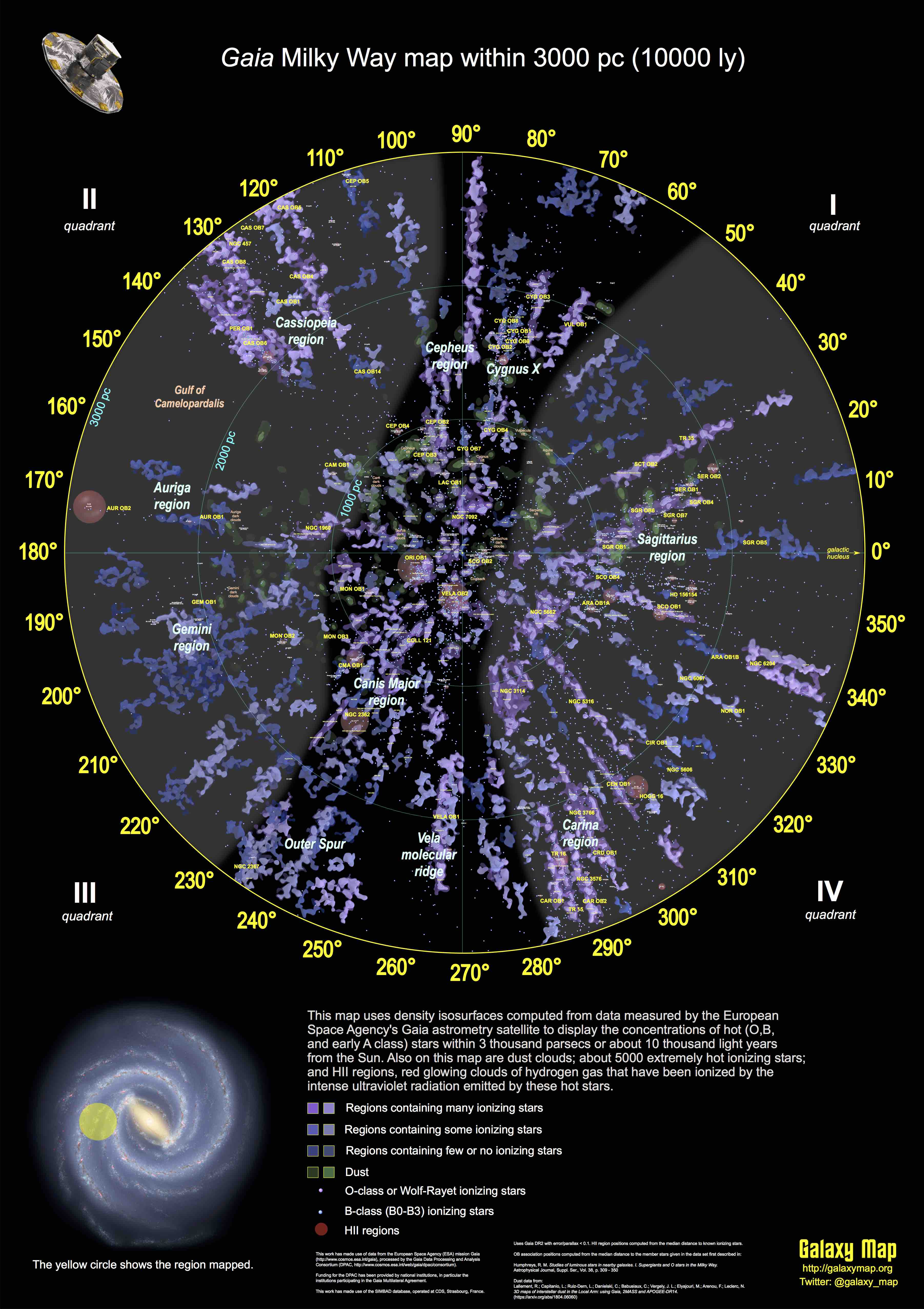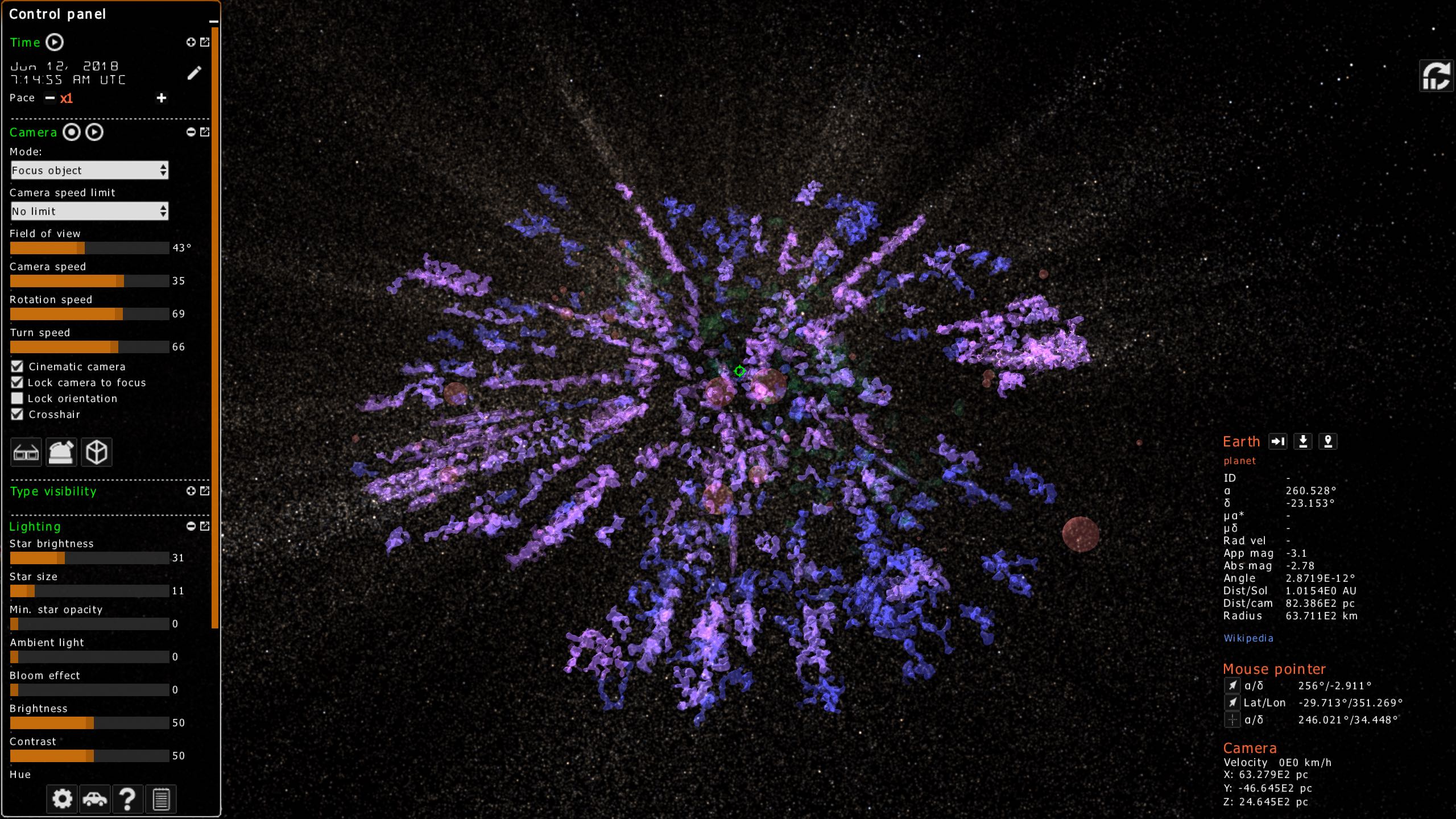IoW_20180614 - Gaia
Image of the Week |
Mapping and visualising Gaia DR2 |
 |
|
Figure 1: Map of the Milky Way within 3000 parsec of Earth as created by Galaxy Map / Kevin Jardine (webversion of this map allowing some interaction with the map is available here, and a downloadable file with the poster is available here). Image credit: Galaxy Map / Kevin Jardine. |
|
How do you display a map of a billion stars? Astronomers have been mapping the sky for thousands of years but the unprecedented nature of Gaia DR2 presents new challenges, both in the scale of the dataset and its three-dimensional (3D) nature. The solution showcased in the image above utilizes density isosurfaces, a technique more commonly used in industry (for example by the oil industry to model gas flows or by medical technicians to extract bone or other tissue images from MRI scans). This 3D map was developed by Kevin Jardine of Galaxy Map by first extracting the 72 million low error stars with error/parallax smaller than 0.1, and then selecting the 400 thousand stars from this set with negative colour index within 3000 parsec. This selection allows to select mostly OB stars which are young and largely located in associations, typically close to the Galactic plane. This data set was converted into a scalar field by Gaussian smoothing the number of stars per cubic parsec and rendered into three-dimensional density meshes using the marching cubes algorithm. The mesh regions were then coloured based upon the number of Gaia DR2 stars with ionizing colours (colour index < -0.2) they contained: purple (>= 10 Gaia DR2 ionizing stars), light blue (between 4 and 10 Gaia DR2 ionizing stars) and dark blue (<= 4 Gaia DR2 ionizing stars). Also plotted on this map are a selection of ionizing stars as shown with dots on the map. These seem to line up largely with the isosurfaces shown. The gray shading behind parts of the map is intended to highlight the assumed inner and outer parts of the galaxy. The techniques and input data used to create this map are based on the following:
Given that non refereed articles were used to produce this map, this map should be considered as a pure visualisation of Gaia DR2 data and not as a scientific product. To make this map available with the Gaia Sky visualisation software, Kevin Jardine collaborated with Toni Sagrista, developer of Gaia Sky. Gaia Sky is a real-time, three-dimensional, astronomy visualisation software capable of visualising Gaia data. It was used to create some of the videos used at the Gaia Data Release 2 press event. A new version of Gaia Sky is now available and this new Gaia Sky 2.0.1 incorporates some improvements which make it more interesting and exciting to explore the Gaia data with. Figure 2: Same selection as in Figure 1 available in Gaia Sky, visualisation software for exploring Gaia data. (Image source: Gaia Sky, acknowledgement: Toni Sagrista) First of all, the set of isosurfaces in Gaia Sky was updated to include dust maps, HII regions and hot star density isosurfaces of very ionizing, some ionizing and non-ionizing regions, all derived from Gaia DR2 data. This provides further context to explore our part of the Galaxy. In order to enable the meshes, one can click on 'Meshes' in the 'Visibility' pane or use the keyboard shortcut L_CTRL+H. Use the 'Objects' pane to control what specific meshes are rendered and also to get some description of what each mesh represents.
Second, the distribution of stars into our levels-of-detail structure was greatly improved to provide a smoother and pop-in free navigation and traversal of the catalogue. New catalogue files need to be downloaded from the official site to take advantage of this. Of course, the updated version of the default catalogue is already bundled with the application. Some other treats that made it into this new release of Gaia Sky are amongst others the ability to see and export system logs directly from within Gaia Sky, the addition of an FPS limiter and improved, shader-based grid rendering.
|
|
Credits: ESA/Gaia/DPAC, Gaia Sky / T. Sagrista, Galaxy Map / K. Jardine (twitter: @galaxy_map) [Published: 13/06/2018] |
- Removed a total of (9) style text-align:center;
- Removed a total of (19) style text-align:justify;
- Removed a total of (1) border attribute.
- Removed a total of (1) cellpadding attribute.
- Removed a total of (1) cellspacing attribute.
- Converted a total of (1) youtube to youtube-nocookie.
Image of the Week Archive
- Removed a total of (1) border attribute.
- Removed a total of (1) cellpadding attribute.
- Removed a total of (1) cellspacing attribute.








































 Sign in
Sign in
 Science & Technology
Science & Technology
